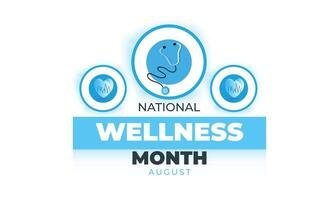What Is National Wellness Month? History, Purpose & How to Celebrate
Discover the history, purpose, and ways to celebrate National Wellness Month in August with self-care tips, wellness activities, and expert insights.

National Wellness Month is celebrated every August in the United States as a reminder to slow down, take care of your body, and find balance in everyday life. It’s about building healthy habits—whether that means drinking more water, moving your body, eating better, or finding ways to manage stress. When you invest in your well-being, you feel better and live better. Wellness isn’t just a passing trend—it’s a lifestyle, and National Wellness Month encourages us to reset and put our health first. ➤ In this article, we are going to explore the history, meaning, and best ways to celebrate this special month while giving you practical, research-backed tips you can start today.
The History of National Wellness Month
National Wellness Month was established in 2018 by Live Love Spa, a wellness community that wanted to help people adopt healthier lifestyles. Since its creation, the observance has grown rapidly in popularity, resonating with Americans looking for balance in a culture often defined by stress and busyness.
Today, the month is recognized by wellness advocates, healthcare providers, schools, and employers nationwide. Its history highlights an important truth: wellness is not a luxury, but a necessity for healthier individuals and stronger communities. By dedicating August to wellness, the movement reinforces that small, daily choices can transform lives over time.
Why August Is Chosen for National Wellness Month
August was chosen intentionally as the observance month. It’s a transitional period: summer is winding down, kids are heading back to school, and routines begin to change. For many people, August feels like a natural time to reset habits before the busy fall season.
Workplaces also tend to experience a mid-year slowdown, making it easier to introduce wellness challenges, team-building events, and healthy lifestyle campaigns. By anchoring National Wellness Month in August, organizers created a seasonal opportunity for people to pause, reset, and focus on self-care.
Also check: If you’re looking for spiritual encouragement while traveling, don’t miss our guide on Scriptures for a Safe Journey: Travel with God’s Promises to find peace and protection on the road
The Purpose Behind National Wellness Month
The purpose of National Wellness Month is to inspire proactive self-care and whole-person health. Unlike initiatives focused only on exercise or dieting, this observance highlights wellness across multiple dimensions: physical, emotional, social, and mental.
The Centers for Disease Control and Prevention (CDC) emphasizes that 6 in 10 adults in the U.S. live with at least one chronic disease, often linked to lifestyle choices such as poor nutrition and inactivity. Observances like National Wellness Month encourage people to take small, preventive steps—such as walking daily or improving sleep—that can lower risks and improve long-term health outcomes.
Understanding the Dimensions of Wellness
Experts, including the National Wellness Institute, identify several dimensions of wellness:
-
Physical: staying active, eating nutritious foods, and getting adequate rest.
-
Emotional: managing stress, practicing mindfulness, and fostering resilience.
-
Social: building healthy relationships and community connections.
-
Financial: managing resources to reduce money-related stress.
-
Occupational: finding satisfaction and balance in work life.
-
Environmental: living in safe, sustainable environments.
-
Spiritual: finding meaning and purpose.
By evaluating each area, individuals can recognize strengths and areas for growth. National Wellness Month is a reminder that wellness is multi-dimensional—true health means balance across all areas, not perfection in one.
Why National Wellness Month Matters Today
Modern American lifestyles often prioritize productivity over well-being, and this imbalance takes a toll. Chronic stress affects about 77% of U.S. adults, according to the American Psychological Association, contributing to burnout, heart disease, and poor mental health.
At the same time, Americans are spending more than ever on wellness. In fact, the U.S. accounts for the world’s largest wellness market, with average annual spending exceeding $6,000 per person on areas like nutrition, fitness, therapy, and alternative health.
National Wellness Month matters because it encourages preventive care, lifestyle changes, and stress management. It serves as a cultural checkpoint, reminding people that investing in wellness now can improve health outcomes and quality of life long-term.
How to Celebrate National Wellness Month at Home
Celebrating at home doesn’t require drastic changes. Start with small, practical steps:
-
Drink more water throughout the day.
-
Cook fresh, balanced meals at home.
-
Practice gratitude journaling before bed.
-
Take short movement breaks instead of long stretches of sitting.
Families can create shared goals such as evening walks, screen-free weekends, or trying new forms of exercise together.
Another powerful option is a social media detox. Research from the Mayo Clinic shows that reducing screen time can improve mood, increase physical activity, and strengthen in-person connections.
Workplace Ideas for National Wellness Month
Workplaces play a critical role in wellness. Employers can support National Wellness Month by:
-
Offering step-count or hydration challenges.
-
Hosting lunchtime yoga or meditation sessions.
-
Encouraging “walking meetings” instead of seated ones.
-
Providing access to wellness resources like apps or workshops.
The benefits are measurable. According to the CDC, workplace wellness programs yield a $3–$6 return on investment for every $1 spent through reduced absenteeism and lower healthcare costs. Harvard research also found significant reductions in cardiovascular risk among employees participating in structured wellness programs.
When employers invest in wellness, they support both healthier workers and stronger business outcomes.
Self-Care Practices During National Wellness Month
Self-care is often misunderstood as indulgence, but it’s about daily choices that protect mental, physical, and emotional health. Practical self-care practices include:
-
Setting firm boundaries to prevent burnout.
-
Taking 15 minutes daily for mindfulness or quiet reflection.
-
Scheduling regular preventive health checkups.
-
Prioritizing adequate sleep and rest.
National Wellness Month offers the perfect reminder that self-care is not selfish—it’s essential to living a healthier, more balanced life.
The Role of Nutrition in Wellness
Nutrition is a cornerstone of wellness. A diet rich in fruits, vegetables, lean proteins, and whole grains supports energy, focus, and long-term health. According to the USDA, only 1 in 10 American adults meets recommended fruit and vegetable intake guidelines, highlighting the need for improvement.
During August, many wellness campaigns promote hydration challenges, meal-prep strategies, and cooking education to inspire healthier eating habits. Even small adjustments—like replacing sugary drinks with water—can have a measurable impact.
Fitness and Movement Goals in August
Movement is one of the most powerful wellness tools. The CDC recommends at least 150 minutes of moderate activity per week, yet fewer than 25% of U.S. adults meet this standard.
National Wellness Month encourages people to set approachable goals: walking 30 minutes daily, stretching, or joining a group fitness class.
Emerging trends in 2025 include wearable technology, which helps track sleep, steps, and stress, as well as CBD-infused recovery treatments and smart-home fitness equipment. These tools are making exercise more engaging and accessible.
The Importance of Mental Health
Mental health is inseparable from overall wellness. Rising levels of anxiety, depression, and burnout in the U.S. make mental health care vital.
Ways to celebrate this dimension during August include:
-
Practicing mindfulness or meditation with guided apps.
-
Seeking therapy or counseling services when needed.
-
Scheduling “mental health days” to recharge.
By promoting openness and reducing stigma, National Wellness Month helps normalize the idea that seeking help is a sign of strength, not weakness.
Family Wellness Activities in August
Families can make National Wellness Month fun and meaningful by:
-
Organizing outdoor activities like hiking, biking, or swimming.
-
Cooking new healthy recipes together.
-
Hosting wellness-themed game nights.
-
Starting gratitude practices with children.
Teaching children wellness skills early helps build lifelong healthy habits and creates stronger family bonds.
Community Events and National Wellness Month
Across the U.S., local communities host events such as wellness fairs, 5K runs, outdoor yoga, and nutrition workshops. Cities often partner with YMCAs, community centers, and health clinics to make resources accessible.
Participating in these events helps residents connect socially while learning practical ways to improve their well-being. National Wellness Month thus becomes not just personal, but collective—strengthening entire communities.
Read: If you’re interested in how wellness fits into the bigger picture of lifestyle and society, check out our guide on American Pop Culture 2025: Trends, Music, Fashion & Viral Moments.
Tracking Your Progress During National Wellness Month
Tracking is one of the simplest ways to stay motivated. You can use a fitness tracker, a journal, or even a wall calendar to record:
-
How many days you drank enough water.
-
Number of minutes spent exercising.
-
Hours of quality sleep.
-
Mood ratings or stress levels.
The act of monitoring progress creates accountability and makes small wins more visible, which boosts motivation.
Long-Term Benefits of Participating
The goal of National Wellness Month is not temporary change but lifelong habit-building. People who actively participate often report:
-
Lower stress and anxiety.
-
Better sleep patterns.
-
Stronger relationships.
-
Reduced healthcare costs.
-
Greater overall happiness.
As the CDC emphasizes, preventive care is more effective and affordable than treatment after illness begins. National Wellness Month plants the seeds for sustainable habits that last long beyond August.
Wellness Challenges to Try
Wellness challenges add accountability and excitement. Ideas include:
-
30-Day Yoga Challenge for flexibility and stress relief.
-
Hydration Challenge to meet daily water intake goals.
-
Digital Detox Challenge to cut screen time.
-
Volunteering Challenge to boost social and emotional wellness.
-
Preventive Health Checkup Challenge for doctor, dentist, or vision visits.
These activities combine fun with measurable health benefits, making them ideal for both individuals and groups.
Chart: Wellness Habits in the U.S.
Average Daily Wellness Habits Among U.S. Adults in 2025
|
Habit |
% of Adults Practicing Regularly |
|
Drinking 8+ cups of water |
45% |
|
Exercising 30 mins daily |
38% |
|
Practicing mindfulness |
27% |
|
Getting 7–8 hrs of sleep |
52% |
|
Eating 5 servings fruits/veg |
34% |
|
Limiting screen time |
21% |
Source: U.S. Centers for Disease Control and Prevention (CDC), 2024–2025 estimates
Wellness isn’t just about personal health—it also reflects larger cultural shifts. If you’re interested in how lifestyle, self-care, and community values are influencing society this year, check out our guide on Emerging Cultural Movements of 2025: Trends Shaping the Year Ahead
Conclusion
National Wellness Month is more than a date on the calendar—it’s an invitation to put your health and happiness first. From self-care practices to workplace programs to family activities, August provides the perfect reminder to adopt habits that support long-term well-being.
By engaging in National Wellness Month, you’re not just improving your health—you’re joining a nationwide movement that values balance, prevention, and resilience. Small steps taken today can lead to lasting changes tomorrow. Let this August be the month you reset, recharge, and commit to living well all year long.
FAQs
What is National Wellness Month?
National Wellness Month is observed in August to encourage Americans to prioritize self-care, fitness, nutrition, mental health, and overall well-being.
Why is National Wellness Month in August?
August was chosen because it’s a transitional month—an ideal time to reset habits before the busy fall season.
How can families celebrate National Wellness Month?
Families can join outdoor activities, cook nutritious meals together, or practice mindfulness as a group, strengthening both health and relationships.
What are some workplace ideas for National Wellness Month?
Employers can organize step challenges, wellness workshops, and mental health breaks. Research shows these programs save companies money through lower healthcare costs and reduced absenteeism.
Is National Wellness Month only about physical health?
No. It also addresses emotional, social, financial, occupational, and spiritual wellness, making it a truly holistic observance.

 Selina Smith
Selina Smith 














